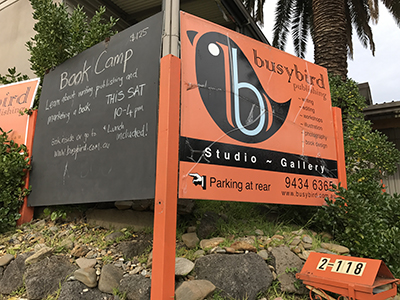

Month: August 2017
Welcome to the Busybird blog, where you can find helpful articles, updates, industry news and more. Make sure you stay up to date by signing up to our newsletter below.
Breaking Down Content: Part I
August 24, 2017 Lots of writers look for a formula in writing, e.g.
Lots of writers look for a formula in writing, e.g.
- a novel should be 80,000 words
- each chapter should be 2,000 words
- 80,000/2,000 = 40 chapters.
And then they’ll try write to that template. The problem is that in any given chapter, you might wrap up what needs to be said in 700 words. What do you do for the next 1,300 words? Some writers will waffle to pad everything out. This isn’t even good in theory. If I was telling you a story and finished it in seven minutes, but then talked at you for another thirteen minutes about the same thing, would you be entertained or bored?
Mathematical breakdowns do not apply in writing. A story – and a book, for that matter – is as long as it needs to be. So is a chapter. And a paragraph. And a sentence.
This doesn’t mean your 90,000-word book should be one long paragraph – although it can, if it justifies it. But that’s the qualification: justification. Every (narrative) selection needs a justification as to why it exists as it does. Many writers don’t contemplate that. They just write where the writing takes them.
Consider this exercise:
- The Premise: you come home and stumble upon a dead body in the kitchen.
– Write out the scene, but don’t use more than four words in any sentence.
– Now try the same scene, but don’t use any less than four words in any sentence.
How do the pieces compare? What tone do the short sentences communicate compared to the longer sentences? It’s worth thinking about, because it helps you to understand the shape of writing, and the purpose that brevity or length can communicate beyond what the words themselves are saying. It also helps to understand that content should justify its own length, and how it’s delivered.
Once you begin to understand the small building blocks, you can start looking at the big building blocks, e.g. the chapters. Some authors struggle with this. They understand their concept as this big blob. For example, the blob might be any of these:
- Fiction: a wife tries to clear herself after she is accused of her husband’s murder
- Biography: the story of Joe Blow, who rises from humble beginnings, becomes a councilman and grows to be invaluable to his local community
- Nonfiction (Topical): why the German Shepherd is the ideal dog breed for a pet
- Nonfiction (Inspirational): How to emerge from an abusive relationship and rebuild your life.
These examples demonstrate content as a concept. They’re whole – that’s the blob. This then leaves you with two questions:
- How do I break that concept down?
- How does the breakdown deliver the message I want to share? (Note: the message might be the plot of the story, the life of a biography, or the message of a nonfiction fiction.)
The first and most basic thing to understand is that chapters don’t all need to be a relatively equal length. They can be. But they don’t need to be. They can be as short or long as needed, and written in whatever form helps deliver your concept. Mark Haddon’s The Curious Incident of the Dog in the Night-Time alternates between traditional narrative and puzzles, which helps define the 15-year-old protagonist as somebody who is different (the blurb suggests he might have Asperger’s or a form of autism, but the author has denied this and just says he’s different).
Writers can gravitate towards compartmentalizing through length as it helps them impose order on their content. But a more efficient way of understanding narrative and structure is compartmentalization through subject, i.e. What will each chapter be about? And, following that question is this one: How does each chapter contribute to my content overall?
You could outline the sum of your content this way. Some authors do. Others prefer to write on-the-fly, but even if it seems as if they’re making it up as they go along, they would be following a similar guide in their heads. Others might outline, but if the content evolves into something else, follow it wherever it takes them. But in each case there should be a purpose. A direction. A plan. This would help segment the content into a logically causal narrative that builds to deliver the content as a whole and, thus, whatever message the author is trying to impart.
Nonfiction would be treated as little different – especially if you were focusing on some sort of biography, e.g. autobiography or memoir, a biography, or a family or community history. You would break it down into what each chapter was trying to do and how it contributed to the overall story. If it was something topical, you’d look at each facet, and how that built the bigger picture.
A useful tool in planning out any form of writing is to bullet point it by topic. But don’t do it chronologically. Try it this way:
- Write down where your content begins
- Write down where it ends
- Write what you think is the middle of your content (this may change later)
- Write down a point that comes between the start and the middle
- Write down a point that comes between the middle and the end
- Continue to break it down, adding ‘middle’ points (between the other points) until you’ve fleshed out your content and covered everything you need to cover
- Look at the chronology, and see if anything needs to be shifted, anything is repeated, and if anything is redundant
- Note: Don’t repeat yourself. And treat these points as fluid, e.g. you might move them to better satisfy the structure.
This should give you a rough outline, cover what needs to be said, and build the structure of how that content is going to be delivered.
On the next blog, we’ll look at a more detailed chapter breakdown to help outline whatever you’re writing.
What Goes in the Pot …
August 10, 2017 Sitting outside the Busybird Studio are two bits of signage (right) – one is a placard of the business; the second is a chalkboard, which we use to spruik upcoming events.
Sitting outside the Busybird Studio are two bits of signage (right) – one is a placard of the business; the second is a chalkboard, which we use to spruik upcoming events.
Not too long ago, an elderly man wandered in to query us about reprinting an old family history. Once we finished talking about the particulars, he asked about the event being advertised on the chalkboard – at that time it was Novelling. We explained that Novelling broke down the craft of writing a novel into simple, understandable components.
‘What’s there to know?’ the old fella asked. ‘Doesn’t it all just come from here?’ He held both hands up to his temples.
That seems a popular misconception from anybody who doesn’t write: all you have to do is sit down, and translate your imagination onto the page. It’ll all come quickly. Easily. And, naturally, it’ll all make sense.
But why should it?
Outside of the presumption, why should it make any sense? It’s tantamount to suggesting you can bake a chocolate cake simply by guessing what ingredients are required, throwing them into the mix, and then shoving it into oven. What do you think the result would be?
Writing is hard.
Writing something good is harder still.
Just as baking a cake would require a precise measure of ingredients, a strict methodology in how they’re combined, and a design in how it’s baked, writing requires much more than just an imagination. An imagination will give you ideas. That’s it. Staying with our cooking analogy, it would be the equivalent to the thought, I’d like to bake a chocolate cake today. From there, it requires technique, a plan, and diligence. Anything less, and who knows what the result would be?
You could fluke it.
Likelier, you wouldn’t because just as when you approach any endeavor, you need to know and understand how it functions, what’s required, and what’s needed to excel. You wouldn’t expect to walk into a kitchen and be a master chef, or onto a tennis court and expect to be a champion, or into a surgeon’s theatre and expect to know how to operate.
Writing is no different.
You need to understand how structure works, what POVs are, how to plot (and subplot), what VOICE is, how to make characterisations dimensional, what arcs are, how to design and layer your world so that it’s believable, how to avoid pitfalls such as exposition, show versus tell … and this list goes on and on.
Although many might think writing is little more than a hobby, a fun thing to do with bits of your imagination firing away and wanting to tell a story, it – as a craft – deserves respect.
Especially if you want to give it your best shot.
